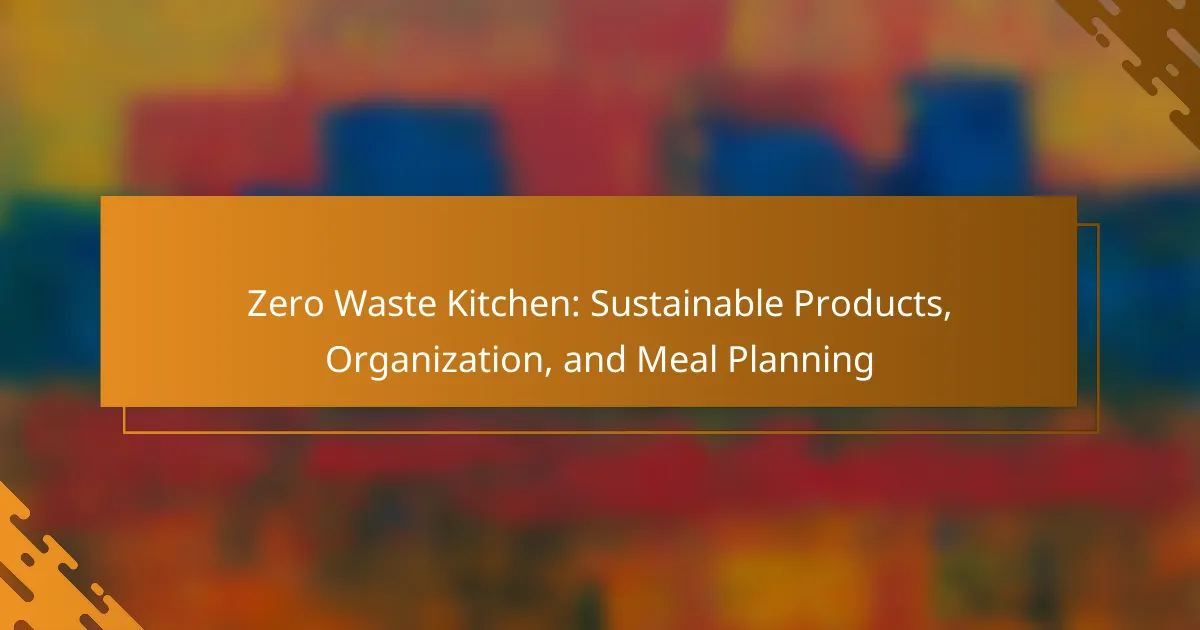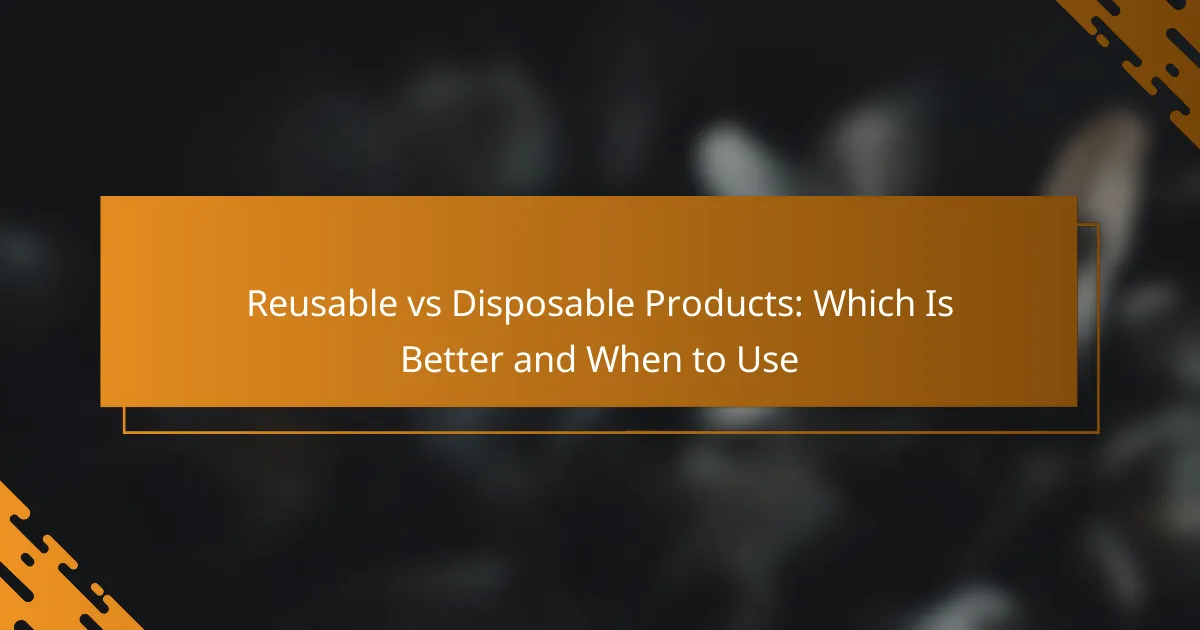Creating a zero waste kitchen involves selecting sustainable products that reduce reliance on single-use plastics while enhancing functionality. By organizing your space with eco-friendly storage solutions and implementing effective meal planning strategies, you can significantly minimize waste and promote a more sustainable lifestyle. Embracing these practices not only benefits the environment but also improves the efficiency of your kitchen.

What are the best sustainable products for a zero waste kitchen?
The best sustainable products for a zero waste kitchen are those that minimize waste while being functional and durable. These items help reduce reliance on single-use plastics and promote a more eco-friendly lifestyle.
Reusable silicone food storage bags
Reusable silicone food storage bags are a fantastic alternative to disposable plastic bags. They are made from food-grade silicone, which is safe for storing food and can withstand high temperatures, making them suitable for both freezing and microwaving.
When choosing silicone bags, look for those that are BPA-free and dishwasher-safe for easy cleaning. They come in various sizes, allowing you to store everything from snacks to leftovers efficiently.
Bamboo utensils
Bamboo utensils are a sustainable choice for cooking and serving food. Bamboo is a fast-growing plant that requires minimal resources to cultivate, making it an eco-friendly option compared to traditional plastic utensils.
These utensils are lightweight, durable, and biodegradable. When selecting bamboo utensils, ensure they are sourced from responsibly managed forests and avoid those treated with harmful chemicals.
Compostable dishware
Compostable dishware is designed to break down naturally in composting environments, reducing landfill waste. Made from materials like sugarcane, palm leaves, or bamboo, these products serve as an excellent alternative to plastic plates and cutlery.
When using compostable dishware, check for certifications that confirm their compostability, such as ASTM D6400 or EN 13432. This ensures they will decompose effectively in commercial composting facilities.
Glass storage containers
Glass storage containers are a versatile and sustainable option for food storage. Unlike plastic, glass does not leach chemicals into food and is fully recyclable, making it a healthier choice for your kitchen.
Look for containers with airtight lids to keep food fresh longer. They are available in various sizes and shapes, making them suitable for meal prep, leftovers, and even baking.
Beeswax food wraps
Beeswax food wraps are a reusable alternative to plastic wrap, made from cotton infused with beeswax, tree resin, and jojoba oil. They can be molded around food items and containers, providing a breathable cover that keeps food fresh.
To maintain beeswax wraps, wash them in cool water with mild soap and avoid using them with raw meat or hot foods. With proper care, they can last for up to a year, significantly reducing plastic waste in your kitchen.

How can I organize my zero waste kitchen?
To organize a zero waste kitchen, focus on using sustainable storage solutions, creating composting systems, and establishing recycling areas. This approach not only minimizes waste but also enhances efficiency and accessibility in your kitchen space.
Use glass jars for bulk storage
Glass jars are an excellent choice for bulk storage as they are durable, reusable, and non-toxic. They can be used to store grains, legumes, spices, and snacks, helping to reduce packaging waste significantly.
When selecting jars, consider various sizes to accommodate different items. Label each jar clearly to make it easy to identify contents and maintain organization. This practice also encourages buying in bulk, which can save money over time.
Implement a compost bin
A compost bin is essential for managing organic waste in a zero waste kitchen. It allows you to recycle food scraps, coffee grounds, and yard waste into nutrient-rich compost for gardening.
Choose a composting method that suits your space, such as a countertop bin for small kitchens or an outdoor compost pile for larger areas. Regularly turning the compost and maintaining moisture levels will facilitate decomposition and minimize odors.
Designate a recycling area
Creating a designated recycling area helps streamline waste management in your kitchen. Use clearly labeled bins for different materials like plastics, paper, and metals to encourage proper recycling habits.
Check local recycling guidelines to ensure compliance with accepted materials. This knowledge will help reduce contamination and improve the effectiveness of your recycling efforts.
Utilize drawer dividers for utensils
Drawer dividers are a practical solution for organizing utensils and kitchen tools, making them easy to find and access. By keeping similar items together, you can maintain a clutter-free environment.
Consider adjustable dividers that can be customized to fit your drawer size and accommodate various utensils. This organization method not only saves time but also reduces frustration when cooking, enhancing your overall kitchen experience.

What meal planning strategies support zero waste?
Effective meal planning strategies can significantly reduce food waste by ensuring that you buy only what you need and use all ingredients efficiently. By organizing meals and shopping smartly, you can minimize leftovers and make the most of your groceries.
Create a weekly meal plan
Creating a weekly meal plan helps you visualize what you will eat each day, making it easier to use ingredients before they spoil. Start by selecting recipes that share common ingredients to maximize usage and minimize waste.
Consider planning meals that can be easily adjusted based on what you have on hand. For instance, if you have extra vegetables, incorporate them into soups or stir-fries to ensure nothing goes to waste.
Shop with a grocery list
Shopping with a grocery list is crucial for sticking to your meal plan and avoiding impulse purchases that can lead to waste. Before heading to the store, review your meal plan and make a list of the specific items you need.
Try to stick to the perimeter of the store where fresh produce, meats, and dairy are typically located. This approach helps you avoid processed foods that often come with excess packaging and contribute to waste.
Batch cook meals
Batch cooking involves preparing large quantities of meals at once, which can save time and reduce food waste. Choose a day each week to cook multiple meals that can be stored in the fridge or freezer for later use.
Label containers with dates and contents to keep track of what you have. This practice not only helps you use ingredients efficiently but also makes it easier to grab a quick meal without resorting to takeout.
Use leftovers creatively
Using leftovers creatively can help you avoid throwing away food. Transform leftover ingredients into new dishes, such as turning roasted vegetables into a frittata or using stale bread for croutons or breadcrumbs.
Consider keeping a “leftover night” once a week where you use up any remaining food in your fridge. This not only reduces waste but can also lead to fun and inventive meals.

What are the benefits of a zero waste kitchen?
A zero waste kitchen offers numerous advantages, including a significant reduction in environmental impact, long-term cost savings, and healthier food choices. By adopting sustainable practices, you can contribute to a cleaner planet while enhancing your overall well-being.
Reduced environmental impact
A zero waste kitchen minimizes waste generation, which directly benefits the environment. By using reusable containers, composting food scraps, and avoiding single-use plastics, you can significantly decrease landfill contributions and reduce pollution.
Consider implementing practices like bulk buying to reduce packaging waste and choosing local produce to lower your carbon footprint. These small changes can collectively have a large positive effect on the environment.
Cost savings over time
Transitioning to a zero waste kitchen can lead to substantial cost savings in the long run. By investing in durable, reusable products and planning meals to avoid food waste, you can decrease your grocery bills and reduce unnecessary spending.
For example, purchasing items in bulk often comes at a lower price per unit, and meal planning can help you use ingredients efficiently, minimizing spoilage. This approach not only saves money but also encourages mindful consumption.
Healthier food choices
A zero waste kitchen promotes healthier eating habits by encouraging the use of fresh, whole ingredients. When you focus on reducing waste, you are more likely to prepare meals at home, which often leads to better nutrition compared to processed foods.
Additionally, by choosing local and seasonal produce, you can enjoy fresher options that are often more nutrient-dense. This shift not only benefits your health but also supports local farmers and reduces the environmental impact associated with transporting food over long distances.

What criteria should I consider when selecting zero waste products?
When selecting zero waste products, prioritize sustainability, durability, and functionality. Look for items made from eco-friendly materials that can withstand regular use and contribute to reducing waste in your kitchen.
Material sustainability
Material sustainability refers to the environmental impact of the resources used in a product’s creation. Choose products made from renewable, biodegradable, or recycled materials, such as bamboo, glass, or stainless steel. Avoid plastics that are not recyclable or made from fossil fuels.
Consider certifications like the Forest Stewardship Council (FSC) for wood products or Global Organic Textile Standard (GOTS) for textiles, which indicate responsible sourcing. This ensures that the materials not only minimize waste but also support sustainable practices.
Durability and lifespan
Durability and lifespan are crucial factors in zero waste products, as longer-lasting items reduce the need for replacements. Opt for products that can withstand wear and tear, such as heavy-duty glass containers or stainless steel utensils. These materials typically last years, minimizing waste over time.
Evaluate the warranty or guarantee offered by the manufacturer, as this can indicate the expected lifespan of the product. A good rule of thumb is to choose items that can last a decade or more, which significantly cuts down on waste and replacement costs.



